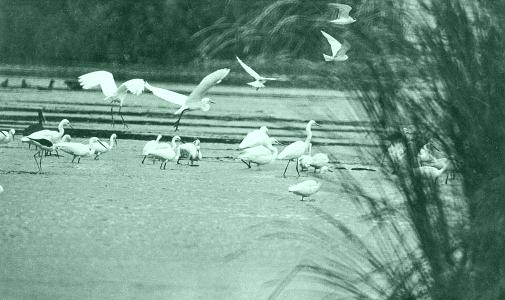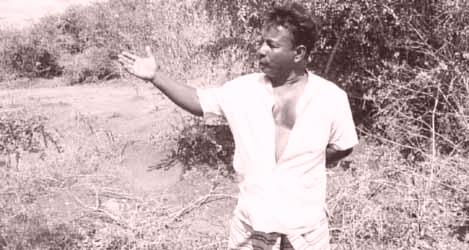 Year on the Web
Year on the Web Year on the Web
Year on the Web



Environmental concerns mount as tanneries prepare to shift operations to picturesque Kalametiya
 Looking
for breakfast in the tranquil waters
Looking
for breakfast in the tranquil waters
Sunrise over Kalametiya lagoon.
Hazy shapes drifting over silvery water. An oarsman lazily pushing a canoe in
the reedy lagoon, looking for early morning catch. Bird cries ring out as the
sun slowly turns colour- deep red to burning yellow and silhouettes sharpen
against the bright light. A sight of sheer tranquility, as far as the eye could
see.
But underneath this serene atmosphere, not far from Hambantota, there is trouble brewing. This previously little known lagoon and surrounding villages have now become the centre of controversy over the proposed relocation of the tannery industry to a site close by. While the authorities plan to go ahead with the plan, which would involve bringing some 15 tanneries now located in Colombo and suburbs to a scrub forest close to the lagoon, environmentalists are railing against the move. In true southern spirit the residents too stand stoutly opposing the project, boldly declaring that 'they would rather die than let the project come through.'
In Colombo the tanneries are having problems of their own- they have been restrained for years because of environmental and health concerns. The tanning of raw animal hide involves chemicals like lead, that are harmful to human health. The industry which at present is largely located in very residential areas close to Colombo like Rajagiriya and Wattala, became a polluter of water sources since the effluent was disposed untreated.
The stench emanating from the tanning process was another concern. Some neighbours found their wells polluted from pieces of decaying hide or meat stolen by scavengers from the tanning centres. Continuous complaints to the authorities about the health hazard to the residents, moved the state to put a clamp on the tanneries in 1989. It was decided that this industry should be relocated to a more suitable site and they were asked not to expand or develop their production, which has been a big blow to the industry as a whole. Finally the state settled on a site at Bata-Ata which is located between Hambantota and Tangalle towns. The site is quite close to the sea and further, close to Kalametiya lagoon, from which the industry proposes to draw its water requirement.
Kalametiya, the lagoon and the village were not prominent locations on the map until this project came to light. The only visitors there until now, would have been ardent bird watchers and people scouting locations for hotels or prawn cultivation. People in the relaxed fishing hamlets that surround the area have been shaken rudely awake from their lethargy by groups who are hotly lobbying against the coming of the tanneries. The lobbying has been so strong that some have signed petitions against the project without much idea of what exactly it entailed. All they knew was that they did not want this project to come to their village. Some were more specific though.
"We would rather be killed than be dumped with these tanneries," Sunil, a fisherman at Gurupokuna said. "Our catch is already reduced because of polluted water from the Embilipitiya Paper Mills coming down the Walawe river to Hambantota. We don't need any more polluters," he threatened, menacingly waving aloft a curved fish knife.
 Sydney:
pointing the scrub
Sydney:
pointing the scrub
"More than the environmental aspect, we have
to consider the fact that we will have to live with the industry for the rest of
our lives. We must consider what kind of village we want to give to our
children,"said K. Sydney, the leader of the protest. He pointed out that
the scrub jungle chosen as the location for the tanneries is on a slight
incline, higher than the rest of the area. "This means that any smell
emanating from the tanneries will spread through the village without much
difficulty," he said.
Others view the tannery project with as much suspicion as they do tourist projects or prawn farm developers, claiming that morality will decline with the 'invasion of industries'.
The board, declaring Bata-Ata a site for industrial development put up by the Ministry of Industries was taken down by the villagers . If they finally move into the village, the industrialists will have to face a great deal of hostility from the sons of the soil there.
After analysing the Environment Impact Assessment done by the Ministry of Industrial Development on the project, the Central Environment Authority declared the project feasible on several conditions. The CEA asked the Ministry to prepare additional reports on obtaining water from Kalametiya which is used for irrigation purposes and the disposal of waste material after the process. "They have yet to come back to the CEA with the reports," Mrs. Shirani Yasarathne, Director Natural Resources Management, CEA said. "When these are analysed we can give the final verdict."
Irrigation Engineer in Hambantota Range, W. Somarathne said that the lagoon has excess water and at the moment there is a problem of drainage there. "Acquiring water from Kalametiya is not a problem," he said. The industry is known to be a water intensive process, it needs an average of 25 litres per kilo of raw hide.
Ashroff Razak of Abdul Cader Ltd. a leading manufacturer of leather products claims that the water used will go through a high tech treatment plant, which will render the waste water suitable for irrigation. He dispelled claims that waste will be dumped in the sea. " 50% of the water requirement will be recycled," Razak said.
As environmentalists point out there is another angle to the problem. The possible threat to bird life at Kalametiya sanctuary. The vast wetland eco system that combines two picturesque lagoons, Kalametiya and Lunama was declared a sanctuary under the WildLife Department in 1984 for its abundance of wild birds, both local and migratory. The lagoon also has thick mangrove swamp cover on the shores and breeds various species of fish in its sedimented waters. The Wild Life Department's protection over Kalametiya is minimal. There are a few dilapidated notice boards declaring the area protected. Already squatters have encroached upon sanctuary land.
The area is internationally regarded as an important location for bird life. But the CEA and the WildLife Department officials said there appears to be little threat to WildLife in the sanctuary because of the project, since there is an overflow of water in the lagoon and waste disposal will be monitored.
While the villagers remain stout in their protests, the tanners are optimistic they would move into the site by next year.
"The work on the treatment plant should begin by end of this year under the supervision of UN consultants," Razak said.
While the need to foster industry and export is definitely a priority, overlooking environmental concerns would not render the best results in the long term. An industry could always survive, but nature could never be recreated. The need of the hour is to strike a proper balance.
Meaning of Judicial Independence
Independence of the judiciary is one of most fundamental elements of a constitutional democracy. The subject assumed significance over the controversial appointment to the Supreme Court in the not too distant past. The comments which follow seek to highlight the superior court's constitutional role and the need to safeguard the independence of judges. They focus on the higher courts but the independence of judges of lower courts involved in the administration of justice is no less important.
Continue to Plus page 4 - Meaning of Judicial Independence
Return to the Plus contents page







Please send your comments and suggestions on this web site to
info@suntimes.is.lk or to
webmaster@infolabs.is.lk